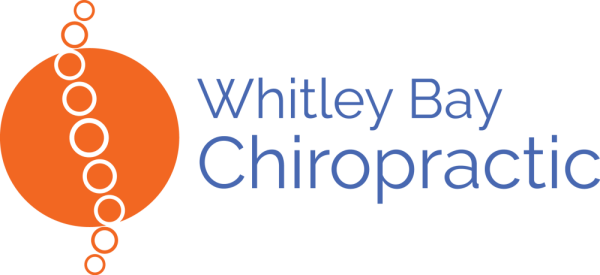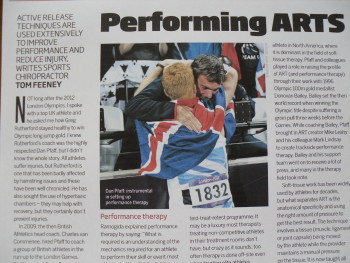Performing ARTS- Athletic Weekly: Dan Pfaff and Gerry Ramogida
This article appeared in Athletics Weekly
Not long after the 2012 London Olympics, I spoke with a top UK athlete, and he asked me how did Greg Rutherford stay healthy, reach his potential, and win gold? I knew Greg’s coach was the highly accomplished Dan Pfaff, but I didn’t know the whole story. All athletes suffer injuries, but Rutherford has been particularly stricken. Rutherford’s struggles with hamstring issues have been well chronicled, as has his use of hyperbaric chambers. They may help with recovery, but they don’t prevent injuries.
In 2009, UK Athletics head coach Charles van Commenee hired Pfaff to coach a group of British athletes in the run up to the London Games. Pfaff tempted Gerry Ramogida away from his day job with the NFL’s Seattle Seahawks to come work with him in the UK. Ramogida is a Canadian Chiropractor who uses fascial work, Active Release Techniques (ART), acupuncture, and movement analysis to improve athlete performance/reduce injury. Pfaff and Ramogida worked trackside with British athletes combining training with therapy, they call it Performance Therapy.
Ramogida describes Performance Therapy:
What is required is an understanding of the mechanics required for an athlete to most effectively perform his /her skill or event. We call it the: athlete, coach, therapist trinity. If each agrees upon and understands the biomechanics required to successfully execute a long jump for example then each member of the trinity can speak the same language and work toward the mechanical model. The coach may use cues to improve mechanics or progressive drill selection through different thresholds of effort. The athlete can use focused efforts to improve faults such as early dorsiflexion (moving the foot towards the shin), and the therapist can direct specific inputs to potentially restricted tissues which can negatively affect movement. Successful identification and treatment of dysfunctional tissues or joints via ART or another form of input ultimately improves movement quality which improves performance and reduces injury. @DrGerryRamogida
Working trackside allows for a test / treat / re-test program. It may be a luxury most therapists treating non-competitive athletes (in an office) don’t have, but crazy as it sounds too often therapy is done off-site even when treating elite athletes. Advocates of Performance Therapy ask how do you know if your input to the nervous system, muscle, or joint has the desired effect if you don’t test it? How do you know which input: manipulation, fascial work, or ART helped if they are all done in one go on an off-site treatment table?
“As an athlete that has constantly struggled with injury throughout my career, the ART therapy performed on me by Gerry, Dan and therapist Andy Burke during the run-up to London 2012 was one of a number of key factors that changed my luck. Though injuries will always be a part of what I do, the trackside approach to therapy really helped bring about a reduction in injury rates, and indeed performance, for me.” Greg Rutherford UK Long Jump Record Holder
ART is well known to almost every athlete in North America, where it is dominant in the field of soft tissue therapy. Pfaff and colleagues played a role in raising the profile of ART (and Performance Therapy) through their work with 100m 1996 Olympic Champion Donovan Bailey. Bailey set the then world record when winning Gold, despite suffering a groin pull three weeks before the games. While coaching Bailey, Pfaff brought in ART creator Mike Leahy and his colleague Mark Lindsay to create trackside Performance Therapy. Bailey and his support team went on to receive a lot of press, and many in the therapy field took note.
Soft tissue work has been widely used by athletes for decades, what separates ART is the anatomical specificity, and using the right amount of pressure to get the best result. The technique involves a tissue (muscle, ligament, or joint capsule) being moved by the athlete, while the provider maintains a manual pressure on the tissue. It is now taught all over Europe (ART Europe) in connection with the popular Selective Functional Movement Assessment, which was created by Physiotherapist Gray Cook. Many ART providers combine ART with the teachings of the renowned French Osteopath Guy Voyer. Pfaff and Ramogida will be teaching Performance Therapy at their facility this autumn in Phoenix, Arizona the World Athletics Center.
Make no mistake, it is down to gifted athletes putting in the work. and performing on the day to win medals. Coaches and therapy staff have their role to play, and adding trackside Performance Therapy is key to maximizing athletic potential.
Follow me on Twitter Manual Therapy UK
Articles I wrote or contributed to:
Telegraph The ART of Active Release Techniques for Injuries
STACK New Age of Golf Training is Creating Stronger and More Athletic Golfers
Athletics Weekly Performance Therapy for Greg Rutherford
220 Triathlon ART- How is it different from sports massage
Vigour Magazine ART can release tight muscles to improve performance
Progenex ART for CrossFitters
FIT Institute Research based hamstring therapies
TPI What Performance Therapy Looks Like For Top Golfers

